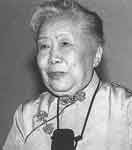.
Chien-Shiung Wu

Chien-Shiung Wu (吳健雄 Pinyin: Wú Jiànxíong) (May 31, 1912 - February 16, 1997) was a female Chinese American physicist with an expertise in radioactivity. She worked on the Manhattan Project (to enrich the uranium fuel) and disproved the conservation of parity. Her nicknames to many scientists are "First Lady of Physics," "Madame Curie of China" and also "Madame Wu".
China
Although her ancestral family home is Taicang (in Jiangsu Province), Wu was born in Shanghai. Her father, Wu Zhongyi (吳仲裔), was a proponent of gender equality and founded Mingde Women's Vocational Continuing School (明德女子職業補習學校), where Chien-Shiung Wu had her entire elementary education until she left her hometown at the age of eleven to go to the Suzhou Women's Normal School No. 2. Her mother was Fan Fuhua (樊復華).
She was admitted to the National Central University in 1929. According to the government regulations of the time, normal school students entering universities needed to serve as teachers for one year, so in 1929 she went to teach in the Public School of China (中國公學) founded by Hu Shi in Shanghai. From 1930 to 1934, she studied in the Physics Department of Nanjing Central University (now Nanjing University). For two years after her graduation, she worked with another female researcher, Jing Weijin (靜薇進), in the university.
America
In 1936, she went to the USA with a female friend, Dong Ruofen (董若芬), a chemist from Taicang. Wu studied at the University of California, Berkeley and received her Ph.D in 1940. She married Luke Chia-Liu Yuan (袁家騮,袁世凯之孙)(the grandson of Yuan Shikai), also a physicist, two years later. They had a son, Vincent (袁緯承), who became a physicist as well. The family moved to the East Coast, where Wu taught at Smith College, Princeton University, and Columbia University (1957).
She assisted Tsung-Dao Lee personally in his parity laws development (with Chen Ning Yang) by providing him with a possible test method for beta decay in 1956 that worked successfully. Some consider this very instrumental in the creation of the laws, but she did not share their Nobel Prize - a fact widely blamed on sexism by the selection committee. Her book Beta Decay (1965) is still a standard reference for nuclear physicists.
She later conducted research into the molecular changes in the deformation of hemoglobins that cause sickle-cell disease.
Wu set precedents for womankind on several occasions. She was:
- the first female instructor in the Physics Department of Princeton University;
- the first woman with a Princeton honorary doctorate;
- the first female President of the American Physical Society (1975, through an election).
- Wu won the National Medal of Science in 1975, and the first Wolf Prize in Physics in 1978.
At the time of her death, Wu was Pupin Professor Emeritus of Physics at Columbia.
Memories
The Chinese Academy of Sciences named Asteroid 2752 after her in 1990: the Wu Jianxiong Xing. In 1995, four Chinese/Taiwanese Nobelists—Tsung-Dao Lee, Chen Ning Yang, Samuel C. C. Ting, and Yuan T. Lee—founded the Wu Chien-Shiung Education Foundation in Taiwan for the purposes of providing scholarships to young aspiring scientists.
She died two years later at the age of 84 of a stroke in Manhattan, New York City, USA. Her cremated ashes were buried at the Mingde Senior High School (successor of Mingde Women's School). Her husband (died February 2003) chose to be buried beside her. Her tombstone was inscribed with calligraphy by Tsung-Dao Lee and Chen Ning Yang (for Wu), and Samuel Ting and Yuan T. Lee (for Yuan).
In June 1, 2002, a bronze statue of Wu was erected in the courtyard of Mingde High.
Name
Chien-Shiung Wu's generation name, Chien ("Capable"), is like her brothers', and not a separate name for females (see Chinese name). In addition, her parent-given name, Shiung, means "Hero" or "Conqueror". So, with her given name, many Chinese who first hear of her assume her to be a male.
Chien-Shiung Wu: Pioneering Nuclear Physicist, Ray Spangenburg,Richard Hammond
See also
Nobel Prize controversies
Links
Retrieved from "http://en.wikipedia.org/"
All text is available under the terms of the GNU Free Documentation License

